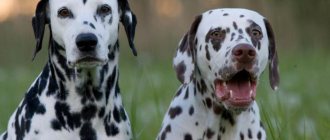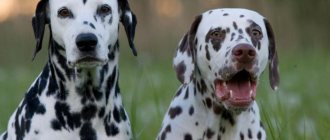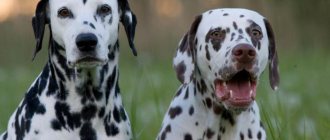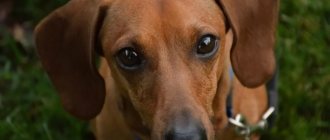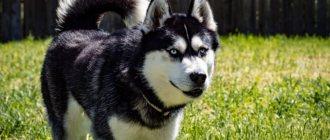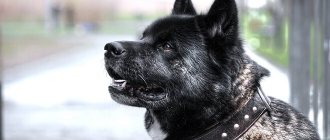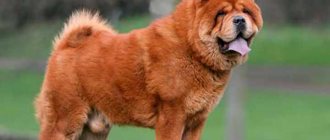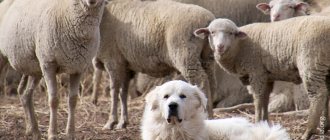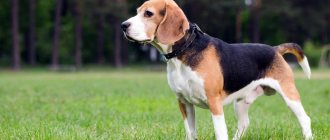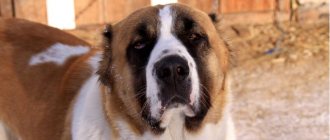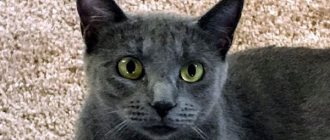Floppy ears not only add special charm to our four-legged friends, but also have a practical meaning. For example, hounds (such as the basset hound) have long ears that help them track prey by picking up and directing scents toward their noses. This explains why most floppy-eared dogs are natural hunters, bred specifically to track game over long distances.
Typically, owners of dogs with floppy ears do not experience any negative health consequences for their pets, although they do have to do extra cleaning since dogs with long ears are more prone to ear infections.
IMPORTANT! Contrary to popular belief, downturned ears do not actually affect a dog's hearing.
Basset Hound
You probably immediately thought of a basset hound when you heard “floppy ears.” Their ears appear even longer due to their elongated snout and tiny legs. Basset Hounds are stellar trackers and are easily recognized by most people. Although these dogs can be quite stubborn, they are generally low maintenance and will remain loyal no matter what.
Did you know that Basset Hounds boast the second best sense of smell in the canine world (after the Bloodhound) and are designed to track and find prey over long distances. Strong and wide paws help them quickly dig out burrowing animals.
Beagle
Beagles have a huge amount of energy, which is funny because they are close relatives of the very docile and calm Basset Hound. Beagles were bred to hunt in packs, so they prefer to be around other dogs or members of their family and require a lot of play time. They are friendly and energetic family dogs, always ready for adventure. But sometimes their energy can be too much for the average family.
Interesting fact: beagles belong to the group of hounds, but, unlike them, they love to bark. And it’s not surprising, because “beagle” “screamer” in French .
Beagles are renowned for their strong sense of smell—the dogs will tirelessly track prey for miles—but they are also known for their large mouths and bottomless stomachs in addition to their luxurious floppy ears.
Hunting breeds
The hunting breeds include the following fold-eared dogs:
- American Cocker Spaniel;
- English Cocker Spaniel;
- Afghan Hound;
- beagle;
- basset hound;
- bloodhound;
- Hungarian Vizsla;
- greyhound;
- drathaar;
- Irish Red Setter;
- Labrador Retriever;
- Russian piebald hound;
- Russian hunting spaniel;
- dachshund;
- Estonian hound.
Dachshund
These walking hot dogs are amazingly tough little dogs. Dachshunds are actually part hound , so they have a strong sense of smell and hunting instincts. Dachshunds have quite a bold character and make excellent watchdogs despite their small size.
Although Dachshunds are not built for long distance running or jumping, they have enormous energy reserves and will be ready for any game, especially those that offer a challenge.
Choose by size
You can choose a fold-eared pet by size. The dimensions of such dogs can vary: from a tiny dwarf dachshund to a huge Great Dane. When choosing a breed, it is worth considering several criteria at once: where the animal will live, for what purpose it is purchased, whether there are children in the family, how active the owner is, etc.
Small breeds
Fold-eared pets of a small breed are suitable for keeping even in a small apartment.
IMPORTANT! Representatives of some breeds may have a rather tough character, and a beginner in dog breeding may not be able to cope with such an animal, despite the small size of the pet.
Bedlington Terrier
The homeland of these terriers with a unique appearance is Great Britain. Adult Bedlington Terriers grow up to 8-10 kg, and their height does not exceed 40-42 cm. Colors allowed by the standard: sand, blue, liver. There may be tan marks on the belly and paws.
The appearance of the terrier is unique: it resembles a small curly sheep. The head is pear-shaped, the jaws are long, the ears hang down, and their set is quite low. The animal's coat is very soft, wavy, and fluffy. Dogs of this breed are very brave, loyal and good-natured towards humans. Bedlingtons are highly trainable and suitable for families with small children.
Bichon Frize
This charming dog is native to France. The height of an adult Bichon does not exceed 28-30 cm, with smaller animals being most preferred. The fur is strictly white in color. The guard hair is soft, long (up to 10 cm), curly.
Bichon Frize dogs are very friendly, love active pastime, and are devoid of aggression towards humans. Due to their small size, these animals can be taught to go to the toilet at home in a special tray, but you should not deprive your pet of regular walks.
Cavalier King Charles Spaniel
The homeland of these small spaniels is Great Britain. At the withers, adult dogs grow no more than 33 cm. Spaniels have very expressive dark eyes, large ears, covered with long curly hair. Throughout the body, the hair is not very thick, of medium length, soft and slightly wavy.
The colors allowed by the standard are: ruby (rich dark red), tri-color, black with bright tan and blenheim (white and cream with bright brown spots).
King Charles spaniels are very active and good-natured animals. They love to go for long walks, are well trained, and are suitable for families with children.
Lhasa apso
The homeland of these decorative dogs is Tibet. The height of an adult apso does not exceed 25 cm. The entire body of the animal, including the ears and muzzle, is covered with long flowing hair. The eyes are dark and small. Acceptable coat colors: black, golden, honey, dark gray, brown, white.
REFERENCE! Lhasa Apso are brave, confident and cheerful dogs. They are very attached to their family, but are wary of strangers.
Maltese
Another name for the breed is Maltese. The Central Mediterranean is considered the homeland of these animals. An adult individual has a height at the withers of no more than 25 cm. The entire body of the dog is covered with long and soft snow-white hair. The nose is strictly black, the eyes are small and dark.
Maltese dogs are real intellectuals. They are happy to learn commands, love outdoor games, are strongly attached to their family, and communicate well with children. Maltese can be distrustful of strangers, but they rarely show aggression.
Pekingese
The Pekingese is a Chinese breed. Adult dogs grow up to 25 cm. The entire body, except the head and muzzle, is covered with thick, long and soft hair of various colors (red, fawn, black, white, multi-colored). The muzzle is slightly flattened, the eyes are set quite widely.
Pekingese are brave dogs, but they also love to be constantly pampered. The animal treats children condescendingly; in the absence of upbringing, it can show aggression. It is better to get such a dog for lonely people who spend most of their time at home.
Dachshund
The homeland of the dachshund is Germany. There are several varieties of these dogs: rabbit (height from 10 to 15 cm), miniature (14-19 cm) and standard (up to 27 cm). According to their coat type, Dachshunds can be wire-haired, long-haired or smooth-haired. Acceptable colors: merle, black or brown and tan, red.
A special feature of the breed is its unique body structure. The dachshund has an elongated body, short and strong limbs. The tail is long and looks upward when excited.
The dachshund is a confident, courageous and non-aggressive animal. Dogs of this breed are excellent and very hardy hunters. They are used in hunting raccoons, foxes, and badgers. With proper training, the dachshund will be an excellent companion.
Medium breeds
Medium breed dogs can live both in the yard of a private house (if they have thick fur) and in even a small apartment. This group is one of the most numerous, so anyone can choose a pet to suit their taste.
American Cocker Spaniel
These animals were brought to the USA. An adult dog grows up to 39-40 cm. The coat of spaniels is medium length, soft, slightly wavy. Acceptable colors: black, chocolate, fawn, tan is also possible. There are spaniels with multi-colored coats.
These animals are curious and very active. With proper training, they can become excellent companions, but many owners do not take these dogs seriously, which leads to aggression on the part of the animal.
Basset Hound
The homeland of these dogs is Great Britain. An adult animal grows up to 38-40 cm. The Basset Hound is a very powerful dog with long ears and folds on the legs and head. The fur throughout the body is short. Acceptable colors: tri-color or white and red.
INTERESTING! Despite their appearance, basset hounds are very active and adventurous animals. They are quite stubborn and willful, so such a pet should not be adopted by a person who does not have experience in raising and raising dogs.
Beagle
The homeland of these popular and charming animals is Great Britain. At the withers, an adult beagle reaches 38-40 cm. Representatives of the breed have a very expressive muzzle, neat drooping ears and fairly large brown eyes of different shades. Beagles' tails are not very long, straight and thick.
The coat is short, but not harsh. The Beagle can be any color characteristic of hounds, with the exception of liver. Most often, three-colored or two-colored animals are found: the main color is white, with large red and black or brown spots on the body. A distinctive feature is that the tip of the tail is always white.
Beagles are excellent hunters. They strive to constantly study everything around them, so they can run away from their owner during a walk. Beagles love the company of people very much, they treat strangers kindly, and are happy to accompany their owner on long journeys.
Boxer
The German boxer was bred in Germany. These are powerful animals, reaching 58-63 cm at the withers. The boxer has a very wide and deep chest, a short muzzle, and a slightly upturned nose. The limbs are quite long and strong. The entire body has a square format.
The Boxer's coat is hard, very short, and shiny. Acceptable colors: red of various shades and brindle. White markings on the body are acceptable. There is always a black mask on the face.
The Boxer is a cheerful, brave and confident dog. Animals of this breed are very attached to their family and can be wary of strangers. In case of danger, the good-natured boxer immediately comes to the defense of family members. These animals will make excellent companions.
Dalmatian
The homeland of these spotted animals is Croatia. An adult Dalmatian reaches 60-62 cm at the withers. The body has an almost square format (the ratio of body length to height is 10 to 9). The iris of the eyes is brown, and can be of different shades (dark in white-black dogs, and lighter in white-brown dogs).
The coloring of the Dalmatian is unique. Small round spots of black or brown color are randomly located on a white background. The ears and tail can be plain or spotted. A special feature is the color of the nose: it must match the color of the spots.
Dalmatians are strong and very active animals. They adapt to any conditions, love to communicate with people, and willingly learn new commands. However, despite their friendly nature, they need quite strict training, so it is not recommended for a beginner to have such a dog.
Golden retriever
The homeland of these animals is Great Britain. An adult retriever reaches a height of 60-61 cm. These animals have a very harmonious physique, a wide chest, and moderately long limbs.
The Golden Retriever's coat is long, wavy, and soft. Color varies from light cream to dark gold. Due to their gentle nature, these animals are excellent companions. At the same time, retrievers are very hardy and active, so they will be happy to accompany their owner on long walks.
Irish Red Setter
The breed was bred in Ireland. Red setters are quite tall animals - at the withers they reach 65-67 cm. These dogs have a harmonious physique, the head is small in relation to the body. The coat is of medium length, the tail, back of the limbs and ears are more richly furred. The color is dark or light chestnut, with a red tint required.
Irish Setters are temperamental and energetic animals. Such a dog needs long walks, games, and activities. With proper training, the setter is an excellent companion for an active family.
Labrador Retriever
The Labrador is considered a Canadian dog breed. Adult animals grow up to 55-57 cm. The Labrador has a strong, well-built body and a deep chest. The head is fairly wide, but not coarse. The animal's tail is not long, thick at the base and along its entire length.
The Labrador has a “double” coat: a dense undercoat and fairly hard outer hair. Acceptable colors: chocolate, black, fawn in different shades. There are no spots, although a small white mark on the chest is allowed.
IMPORTANT! Labrador is a very kind and extremely active dog. It is necessary to direct its energy in the right direction (hunting, long walks, swimming, etc.), only in this case the animal will become an excellent companion.
Large breeds
Large breed dogs are suitable for lovers of large animals. Some of them have quite a tough character, while others can be an excellent companion for a family, even with small children.
Bernese Mountain Dog
The homeland of these animals is Switzerland. Adult representatives of the breed grow up to 68-70 cm. The physique is powerful and strong. Limbs are straight, with parallel stance. The Bernese's coat is long and thick.
The main color is black, with bright red tan on the paws and belly. There is always a white mask on the face.
The Bernese Mountain Dog is a sociable and moderately active animal. The dog is devoted to its owner and is wary of strangers. Berns are highly trainable, but cannot tolerate too much pressure.
Mastino Neapolitan
The homeland of the Mastino or Neapolitan Mastiff is Italy. This is a very massive animal, height at the withers reaches 72-75 cm. The bones are powerful, the muscles are well developed. The head is very massive. Mastino's ears are drooping and large, but some breeders crop them to prevent ear diseases.
The mastiff's coat is short and slightly rough. Acceptable colors: gray, black, blue, Isabella. Brindle pattern and white markings are acceptable. The Neapolitan Mastino has a rather tough character; they perfectly protect the home and their family. Families with children under 12 years old should not get such a dog.
German dog
The homeland of these large animals is Germany. An adult Great Dane grows to 85-90 cm at the withers. This is a very large animal with a harmonious physique and powerful bones. The ears are floppy, but some breeders crop them. The Great Dane's coat is short and can have a variety of colors: fawn, merle, black, blue, brindle. White markings are acceptable in all colors.
The Great Dane is a sociable and cheerful animal. This dog loves to be close to its owner and prefers long but leisurely walks. Great Danes communicate well and carefully with children.
Saint Bernard
The homeland of these large animals is Switzerland. When adults, St. Bernards grow up to 90 cm. These are very massive dogs with a large head and strong bones. The coat is medium length, thick, red and white in color.
Saint Bernards love people very much and treat children with care. They are obedient, manageable, and easy to train. You should not keep such an animal in an apartment. The best option for keeping it is a spacious courtyard of a private house, closed on all sides.
Tibetan mastiff
Dogs of this breed were bred in Tibet. Adult Tibetan Mastiffs grow over 62-66 cm. This is a massive and large animal, the bones are strong, but not rough. The coat is thick, longer on the neck, tail, back and back of the limbs. Acceptable colors: black, blue or golden with tan; sable; golden in different shades.
The Tibetan Mastiff is a self-confident, rather phlegmatic and reserved dog, but when in danger it instantly attacks a stranger. Tibet is an excellent guard for a private home. These animals are manageable, communicate with children carefully and tolerate any temperature.
Bloodhound
Also known as bloodhounds, bloodhounds are the best dogs for finding missing persons. Their sharpest sense of smell in the canine world can sometimes cause trouble on walks, as they tend to sniff everything. Besides their long, floppy ears (which should be checked daily for ear infections), these hounds have a love of barking like no other. They howl at everything, which is why Bloodhounds are not the best choice for families living in cramped apartments.
Fun fact: Bloodhounds can track up to 210 km away and can follow a scent left almost a week ago. Often used in search and rescue missions, Bloodhounds are considered such accurate trackers that their tracking results can be used in court.
The long, floppy ears are an advantage for the sensitive noses of bloodhounds and add to their charming, soulful appeal. Who wouldn't want to pat the ear of this sweet pie with a sad look?
Cavalier King Charles Spaniel
These little cuties are rightfully popular among dog lovers. In addition to its adorable floppy ears and fluffy coat, the Cavalier King Charles Spaniel has a very affectionate and loving personality . With him you will get a best friend for many years. Cavalier King Charles Spaniels have the gentle and playful qualities of a toy breed, while also embodying the athleticism of a spaniel.
Cocker Spaniel
Cocker spaniels not only have long ears, but also huge hearts and brains. They are generally gentle and sensitive, but always ready to take on a challenge. Cocker Spaniels are easy to train and love to play with children. You just need to spend some extra time grooming their silky coat, but that's a small price to pay to have the best companion in the world.
This small breed is extremely intelligent, agile, playful and adorable. Their small size and boundless energy make Cocker Spaniels excellent students in agility courses, and their eagerness to please their people makes them easy to train.
However, don't let those cute eyes and gentle disposition fool you. Cocker spaniels were bred to chase birds out of the bush when hunting, so they may have a high drive for tracking prey. So it's a good idea to keep them on a leash and in a fenced yard to prevent them from escaping and disturbing local wildlife.
Kurzhaar
Germany is considered the homeland of these animals, and among their ancestors are the pointers brought there from France, Flanders and Spain. German breeders began to infuse them with the blood of pointers and local dogs used for feeding prey.
Shorthaired Pointers are a hunting breed of spotted dogs with a harmonious body, noble posture and well-defined sexual dimorphism. The average height of these animals is 60-65 cm. On a dry head with a long wide muzzle and strong jaws covered with tight lips, there are dark brown eyes and high-set, flat, drooping ears. The slightly elongated body with a strong back and a flat topline is covered with short, coarse, hard coat of a spotted color. Most often, white or dark marks or specks are scattered on a brown background.
Shorthaired Pointers are flexible, friendly and peace-loving dogs, distrustful of strangers. They love to bark and are not too willing to bother with children. They are not at all playful and will not bother their owners, persistently demanding attention.
Weimaraner
Weimaraners are elegant dogs that are always ready for adventure. They need plenty of exercise and love to play with their people. This breed is incredibly loving and easy to train , making Weimaraners excellent family dogs as long as they get enough exercise.
Afghan Hound
Let's be honest, this breed has nicer hair than most people we know. The Afghan Hound is a unique breed with a long, extravagant coat that adorns their ears, making them appear even droopier. These dogs tend to be quite sensitive emotionally, but are extremely loyal to the people they form a bond with.
Did you know that this adorable breed is known as the "Queen of Dogs" . And it's not hard to see why. From long, flowing ears to soft, luxurious fur, these dogs are made for photo ops.
Unlike other hounds with large ears, the Afghan Hound is only a hunter in appearance; it excels in dog racing. They are very intelligent dogs and have a fairly independent nature, which makes them difficult to train.
Porselen
Also called porcelain hound or royal hound . A rare breed, bred several centuries ago in France. This is a hunting dog, originally intended to herd hare, roe deer, wild boar, could follow the scent of a wounded animal, and was used in a pack. The name of the breed comes from its color and graceful exterior.
This is a large dog, 53-58 cm , weighing 26-30 kg . Porselen is an elegant dog with long legs. The coat color is white with orange spots. It has an elongated, extensive skull and a whip-like tail. The ears are thin, pointed, curled inward, reaching the nose when pulled out.
This is a balanced, kind, but active dog at home; during the hunt, it embodies excitement and impulsiveness.
Golden retriever
The Golden Retriever is one of the most popular dog breeds in the world, and for good reason. This dog of extraordinary beauty is used in a variety of capacities, including as a working dog for field work, guide dogs for the blind, service dogs for search and rescue of victims, and companions for children and the elderly. Golden Retrievers are loyal, playful, and very easy to train.
Saluki
These exotic dogs are avid hunters with great strength and endurance. Slender but strong, Salukis are known as agile sprinters who love a good run. But, despite their sporting nature, Salukis are quite gentle and loyal pets.
Did you know that the Salukis were held in such high esteem in Egypt that their bodies were often mummified like the bodies of the pharaohs.
Saluki is one of the oldest dog breeds. This sighthound has been used by Arabs for thousands of years to hunt gazelles. Graceful and independent, Salukis do best with daily exercise. They shed little but require weekly brushing and occasional bathing. Many Saluki owners use a headband to keep their ears away from the food bowl.
Shih Tzu dog
One of the oldest breeds, originally from China, for a long time lived only at the imperial court . The name of the breed translates as “lion cub”. This is a short animal (no more than 27 cm at the withers), body weight - 4.5-8.1 kg . The dog has a slightly elongated body, a large wide head, short limbs and a long tail thrown over its back.
The ears are very long, thick, hanging, profusely pubescent, merging with the neck hair . The coat is abundant throughout the body, dense, not curly, of any shade. On the back of the nose, the hairs grow upward, creating the appearance of a chrysanthemum. The character is calm, not aggressive, independent, arrogant to strangers. Shih Tzus are moderately active, intelligent and alert.
Havanese Bichon
These perky little furballs are full of cheerfulness and energy. Havanese Bichons are native to Cuba . In addition to their floppy ears, they also have a luxurious coat that needs grooming more often than other dog breeds. Be sure to check their ears often to remove wax and wipe the inside of their ears with a paper towel from time to time.
Smooth-haired and short-haired breeds
Short-haired and smooth-haired dog breeds with floppy ears include:
- American Bulldog;
- American Pit Bull Terrier;
- American Staffordshire Terrier;
- English Mastiff;
- Dogo Argentino;
- basset hound;
- boxer;
- bullmastiff;
- Weimaraner;
- Hungarian Vizsla;
- Dalmatian;
- Mastino Neapolitan;
- pug;
- Rhodesian Ridgeback;
- dachshund.
Setter
There are several different setter breeds, including the Irish Setter, Scottish Setter and English Setter - all of which have floppy ears. Setters are native to the United Kingdom and Ireland and are ideal for those who enjoy hiking and hiking . Setters are happy when they have the opportunity to run through forests and fields, up and down hillsides.
IMPORTANT! Setters like to keep an eye on their surroundings, looking out for intruders. This same desire to guard their space can make them want to prowl, so it is recommended to keep these sweet sporting dogs on a leash or in a secure, fenced yard.
Coonhound
Originally bred in the USA, these hard-working, long-eared hunting companions are highly skilled at tracking raccoons, foxes, possums, deer and bears. Their second name is “coon hounds” . The Coonhound hunts equally well alone or with a pack, and can handle even the most difficult terrain. Coonhounds are renowned for their speed and endurance. This athletic hound needs regular exercise to stay in shape.
Fun fact: The breed originated in the late 1700s when hunters in the southeastern United States crossed bloodhounds and foxhounds to create a new hound that could independently track prey and follow tracks over long distances.
Coonhounds are outgoing, playful, and friendly with both people and other dogs. While they may be enthusiastic about chasing, say, a squirrel whizzing by, they're just as happy laying on the couch with their family. However, do not let them remain alone for long, otherwise they will let the whole area know about it with their mournful howl. But the breed’s hard coat does not require special care, and this is a good advantage.
Mikhalkov did not arrive alone
0
According to the director, they first tried actor Nikolai Gubenko for the role of Nikita Mikhalkov - Sir Henry. I tried to persuade him for a long time, but he refused at the last moment. At this time, Mikhalkov was finishing the film “Kinfolk,” in which Svetlana Kryuchkova, who was involved in the film “The Hound of the Baskervilles,” starred. She and her husband (film cameraman Yuri Veksler) had the idea of inviting Mikhalkov to play the role of Sir Henry. Mikhalkov, to everyone’s surprise, arrived at the Lenfilm studio not alone, but with his friend - screenwriter, artist, actor and director Alexander Adabashyan, 12 days before the start of filming. All 12 days the friends walked around Lenfilm, laughed, and discussed something. Filming began, and the actors looked at the director with irony. It got to the point that Mikhalkov began to command on the set.
0
In order to “neutralize” this “gop company”, it was necessary to find something for Adabashyan to do. And then the director came up with the idea: “Let Barrymore play!” This role remained vacant. So Adabashyan became a person subordinate to the director on the set, and he no longer had time to discuss with Mikhalkov whether the director was filming correctly. The Barrymore spouses were played by Alexander Adabashyan and Svetlana Kryuchkova. As a result, the melancholy Adabashyan in the film became a kind of shock absorber, a counterweight to the temperamental Mikhalkov. Their couple fit organically into the whole story. Alexander Adabashyan, who played Barrymore, heartily laying out oatmeal in the film, admitted that in life he eats this wonderful porridge every morning, and considers his role in the film to be stellar. The famous phrase "Oatmeal, sir!" became his calling card. “I haven’t told anyone about this yet: it turned out that I came to audition for this film with... a huge black eye under my eye.” Got into a fight! I won’t say with whom. But I had a classic look... Of course, the group was surprised, looked at me meaningfully, but took it. During filming, I no longer fought, but was completely immersed in work. According to the plot, we needed to create a contrast between old England and new wild America. Sir Henry (Nikita Mikhalkov) arrives from America and finds himself in a completely different environment. To show this, they came up with an outfit for him - a wolf fur coat, meat and wine on the table and, as a contrast, traditional English porridge. It turned out quite funny... The porridge, which the props assistant cooked especially for the film, was so tasty that at the end of filming, another saucepan was brought to the pavilion for the film crew. At the same time, during breaks between filming, guards were assigned to the pot of porridge so that it would not be eaten ahead of time! To make acting more fun, we actors came up with different tricks along the way. For example, I played together with Solomin and suggested that he add some spice to the relationship between our heroes: as if there is such an internal conflict between Barrymore and Watson - the doctor suspects the butler, and in retaliation he doesn’t give him any oatmeal. Such a “confrontation” between the heroes was not in the script; it was entirely our idea.
0
— They say that you and your partners drank heavily on the set? — We drank not during filming, but after. Everyone on camera was sober. When we were returning from filming, the train began to buzz so loudly that the passengers clearly did not sleep that night. “Nikita Mikhalkov, Adabashyan, Vasya Livanov used to lay it down, which infuriated the director,” admitted the combined filming artist Okovity. “But in general, the filming took place in a very fun family atmosphere. That's why the film turned out well.
0
The director was informed that Mikhalkov allegedly “persuaded” a bottle of cognac during his shift and did not eat anything. And during filming he was simply irrepressible. Once he drove a horse to such an extent that it fainted: it lay with its eyes closed, not breathing... Someone decided that that was it, he was dead. But Nikita was able to bring her to her senses.
0
The performer of the role of Dr. Watson, Vitaly Solomin, did not spare himself, literally working without closing his eyes. At the Maly Drama Theater in Moscow, where he played, at that time a performance was being prepared for the next party congress. Rehearsals took place daily and with strict attendance. In “Dog,” filming also took place every day. Solomin spent a week on the train, riding from Moscow to Leningrad and back. I haven't slept well in a week. Encouraging myself, every morning I stood in front of the mirror and said: “Wake up, talented one!!!” Where the County of Devonshire, in which the events of the novel “The Hound of the Baskervilles” unfold, was filmed, Maslennikov’s film was replaced by Estonian landscapes. The Kuistlemma bog played the role of the famous peat bogs of Dartmoor perfectly. Baskerville Hall was filmed in Tallinn, and two buildings served as locations. In the episode where Dr. Mortimer, performed by Evgeniy Steblov, tells the legend of the Baskerville family, Glen's castle appears. It was here that Hugo Baskerville's captive climbed down the ivy from the castle tower window. Baskerville Hall of the 19th century played the castle of Count A.V. Orlova-Davydova. Now it houses the Estonian History Museum. “We were just driving past, somewhere on a hill there was a little house,” recalls Arkady Tigai, the second director. “Suddenly Maslennikov yelled: “Stop, stop! Here he is!" We drove up - there was a real English house. Around the lawn. It was a perfect hit.
Poodle
Intelligent, graceful, and amazingly athletic, poodles were originally bred as hunting dogs. Their bouncy, curly fur does not shed much and serves as an excellent insulating layer in cold or humid climates. Of course, poodles require quite a bit of grooming, whether they have the typical lion cut or you prefer to comb their locks.
Poodles are easy to train due to their intelligence and eagerness to please, and they also excel in sports such as tracking and agility. It is also worth noting that poodles are excellent swimmers, competing with Labradors and golden retrievers.
Bedlington Terrier
The Bedlington Terrier a hardy breed known for its curly coat, was bred in England in the 19th century to catch rats, mice and other rodents. The graceful shape of the body gives the Bedlington Terrier the ability to develop great speed and gives it endurance. Soft and gentle, with a sweet personality, this breed makes a wonderful family companion. The Bedlington Terrier is an energetic but not overly exuberant pet that needs daily exercise. His coat requires regular trimming.
Did you know that the Bedlington Terrier was popular with the Rockefeller family? After William A. Rockefeller's dog Timmy won the Westminster Kennel Club Dog Show in 1948, it wasn't just hunters who became interested in Bedlington Terriers.
What to look for when choosing a puppy
When choosing an eared dog, you need to pay special attention to its appearance and behavior. These factors are the main indicator of the health of the animal.
Criterias of choice:
- eyes - symmetrical, not slanted, without swelling or inflammation;
- ears are clean, the puppy should not constantly scratch them;
- the coat is smooth, shiny, without bald spots, flaking and parasites;
- teeth - without plaque or bruises on the gums;
- paws are strong, straight, ensuring confident movement of the dog.
When looking at the puppy, it should not appear too plump or thin. When purchasing, you need to ask the seller for a puppy card and a veterinary passport, confirming compliance with the standard, as well as the presence of the necessary vaccinations.
Important! A purebred purebred dog cannot be cheap.
The body structure of any puppy, even a dwarf breed, must be strong
Boykin Spaniel
An avid hunter, the Boykin Spaniel is also an affectionate dog that enjoys the company of people and other animals. With a cheerful temperament, the Boykin Spaniel is especially good with children . This energetic breed needs plenty of exercise and thrives in an active family. The Boykin Spaniel's coat ranges from smooth to wavy and requires regular grooming.
Fun fact: The Boykin Spaniel is the official state dog of South Carolina. The first Boykin Spaniels were bred from two strays owned by L. Whitaker Boykin, after whom the breed was named.
The Boykin Spaniel is an excellent upland game and waterfowl hunter and a good turkey dog.
Papillon
This companion dog is a variety of the Continental Toy Spaniel, the country of origin is disputed by several states. An elegant and light creature, height at the withers – 28 cm , weight – from 1.5 to 5 kg .
It has large, erect, high-set ears, and the shells are well open. The hearing organs are strong, shifted back, distant from each other, the inner edge is located at an angle of 45°. The ears are covered with long hair and resemble butterfly wings, which gives the breed its name.
The body is covered with slightly wavy, soft hair of pronounced length, there is no undercoat, there are “frills” and “pants” on the paws. The dog is friendly, devoted to its owner, with a stable psyche.
Breton epañol
This is an excellent hunting dog, able to point at game and retrieve it from cover. Strong, fast, agile and alert, the Breton Spaniard is good-natured and friendly, making him a good companion for families. The breed has thick fur, which protects the pet in field conditions and requires regular grooming. This energetic breed needs daily exercise and does well in a family that enjoys outdoor activities .
Did you know that the Breton Spaniole originated in the French province of Brittany, where the breed was first shown in 1896? But back in the early 1700s, paintings by Jean-Baptiste Oudry showed this white and brown dog stalking partridges.
Harrier
A strong, muscular harrier is an English pack hound originally bred to hunt hares. As an active bloodhound, the Harrier requires moderate exercise to maintain its strength and stamina. This inquisitive hunting breed should be kept on a leash or in a fenced area. Its short, dense coat requires minimal grooming. Sociable and loyal, the Harrier loves to be around people and other dogs.
Did you know that the Harrier was bred from the English Foxhound. Sir Elias de Midhope bred the first pack of these hounds at Penistone in 1260.
Drathaar
A German pointer bred to track game, alert the owner, carry carcasses, and also hunt wild boar. Height – 57-68 cm, weight is not regulated. The body of the animal is almost square, the chest is deep, the stomach is tucked, the tail is of moderate width and can be docked. The ears are set high, set wide apart, fairly long, not pointed or curled.
The coat is hard and short, with pronounced eyebrows and a beard. Colors:
- brown or black with gray hair (with or without spots);
- gray;
- pure brown with or without light chest markings.
The dog's character is balanced, not timid, firm, there is no aggression towards people.
Saint Bernard
A massive and powerful dog, the Saint Bernard was originally bred in Switzerland to rescue travelers stranded during a snowstorm. The breed has two varieties: short-haired and long-haired. Both species have a gentle temperament , making the noble and intelligent Saint Bernard an excellent companion and devoted family dog. But be aware that this breed drools a lot and its coat sheds frequently, requiring regular grooming.
Did you know that the breed was named after Saint Bernard de Menton, the patron saint of climbers and skiers.
Leonberger
Often called a "gentle giant" , the muscular, massively boned Leonberger is distinguished by its lion-like mane and black muzzle. This German dog breed was developed in the mid-1800s as a versatile working dog and family companion. Calm and playful, the Leonberger has a balanced temperament and is always ready to please his loved ones. Its thick, waterproof fur should be brushed daily to avoid matting.
Fun fact: The Leonberger is a cross between a Newfoundland, a Pyrenean mountain dog and a St. Bernard created by Heinrich Essig in 1846 in Leonberg, Germany. A famous German dog handler tried to recreate the lion depicted on the city coat of arms in dog form.
